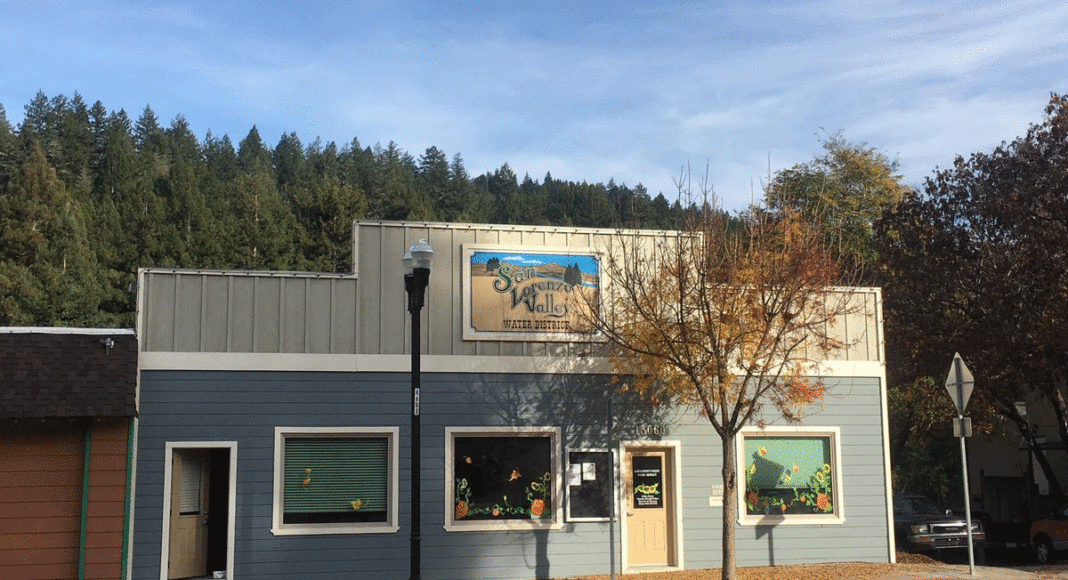With nearly half of the CZU Lightning Complex fire contained, the terrain around it has begun to cool. But the San Lorenzo Valley Water District (SLVWD) does not know when officials will resolve outstanding water quality issues after the heat of the fire destroyed several miles of water supply lines.
SLVWD Water Treatment and System Supervisor Nate Gillespie said on a community Zoom call Thursday that he didn’t know when the water would be safe to drink in all areas of Boulder Creek.
“This is going to be a marathon, not a sprint,” he said.
Currently, there are 354 homes in the district without water, mostly in the area of Big Basin Way and West Park Avenue. SLVWD Interim Manager Rick Rogers said the district will restore service to all remaining customers by Saturday, Sept. 12.
Meanwhile, a do-not-drink order has been issued to 3,197 homes in the district. An SLVWD memo tells water customers affected by the do-not-drink order that they should use bottled water for drinking, brushing teeth, making ice and food preparation. Additionally, the district warns that boiling, freezing, filtering, adding disinfectants, like chlorine, and letting water stand will not make the water safe in the affected areas.
Rogers said the district is working with the county to provide bottled drinking water. Customers may pick up one or two cases of water a day at the district’s operation’s building, located at 13057 Highway 9.
Also, Rogers said the fire destroyed lots of infrastructure, including 7.5 miles of the district’s raw water supply lines—at least some of which were made of HDPE plastic and ran above ground.
Finance Manager Stephanie Hill said the district has $3 million in reserves to help finance the start of emergency repairs. She said district officials are working with FEMA and the California Office of Emergency Services to secure emergency funding for repairs.
Water district officials wouldn’t conclusively say whether the water is safe to use for bathing and showering for customers affected by the do-not-drink order. Gillespie urged customers to err on the side of caution if they were at all concerned about the water quality. On the Zoom call, some community members, including former Santa Cruz County Supervisor Joe Cucchiara, wanted to know why the district didn’t issue a do-not-use order and tell customers that they shouldn’t use the water at all.
Rogers said the district was dealing with the state Water Resources Control Board, which is the responsible agency in this field and that the district was following their processes and timelines.
“It takes a little time,” he said.
The district will post a full video of Thursday’s meeting on slvwd.com.
Follow continuing in-depth fire coverage here and in our live blog.














As someone who listened to the entire 2.5 hour meeting, it sounds like the local water district would like to give more useful information but (in part) is hamstrung by the state regulations dictating what they can and can’t say. The meeting shouldn’t have needed to last 2.5 hours, but there was lots of evasion and jargon which is why it did.
The communications from slvwd have confused a lot of people. Not surprisingly – they cryptic and couched in technical acronyms. For those of us who need to figure out what actions to take or even answer simple questions like “will I be able to bathe?” or “when will you know more?” the absence of clear replies is mystifying and vexing.
It also took them a very long time to post any information at all, and when they did it was a strange “do-not-drink do-not-boil” notice that left many critical questions unanswered. I mean, sure there is uncertainty, but failing to answer is different from describing the parameters of uncertainty.
When the possibilities range from “it probably is totally fine” to “you won’t be able to use any water for anything for over a year,” we really need a more comprehensive explanation of what is going on, so we have some basis for our own decisions. And it shouldn’t have been difficult to provide. For example, they didn’t explain anything about the testing procedure until this meeting, leaving us to wonder about the enigmatic DND/DNB message for days. They should provide ongoing updates about the testing.
After enduring the entire tedious length of the meeting, I feel like I know a little bit more, but really the amount of information I gained could have been summarized very briefly and it’s not as though the questions people asked were unpredictable.
I’m willing to believe they’re more or less doing the right things, but they really need to work on communication in a manner that the lay public can understand and use.
Thank you Jacob for this informative article (and your investigative journalism).
The Water Board’s response to the question of if the water is okay to shower with was extremely frustrating consistently saying that they don’t recommend. However, they won’t put it into writing. This is important to do for those of us that are still under mandatory evacuation and staying in hotels. Insurance companies will extend their coverage from 2 to 3 weeks if it “unsafe to shower, wash dishes, or do laundry.” When asked during the question session directly if they knew it would impact their customers insurance claims, they said they were unaware (41:40). Ridiculous.